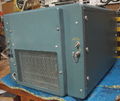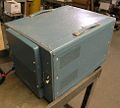556
The Tektronix 556 is a 50 MHz dual-beam scope, the successor to the Tektronix 555.
It uses letter-series and 1-series plug-ins.
A rack-mount version, the R556, also exists.
The 556, which is wider than the average 500-series scope, fits in the 205 cart.
The 556 was the last 500-series scope produced. It was present in the 1974 catalog, but gone in the 1975 catalog. (The dual-beam 7844 had been introduced in 1974.)
Key Specifications
- please add
Links
Dual-Beam Modes
The 556 is a true dual-beam scope and none of the signal path is shared between the two beams. Electrically speaking, the power supply and the calibrator are the only parts that are common to both beams. The 556 has almost complete left-right symmetry, corresponding to upper and lower beams.
Although the beams can be operated completely independently, the 556 provides many options for routing signals between the vertical plug-ins, triggers, sweeps, horizontal and vertical amplifiers. For example, a common use for a 556 is to view two simultaneous single-shot events, both sweeps being triggered by one of the traces. For this purpose, the 556 allows the output of one sweep generator to be routed to the horizontal amplifier of the other beam, so it drives both beams. Many other more sophisticated modes are also available.
Comparison with other scopes
Tektronix 555
The 556 is a one-piece unit whereas the 555 has the power supply in a separate box. Triggering and sweep circuitry is integrated into the 556 mainframe, as opposed to the removable timing units in the 555. The 556 takes two letter-series or 1-series vertical plug-ins. The 556's bandwidth is 50 MHz, whereas the 555's is 30.
The 555 and 556 both use separate HV transformers for the lower beam and upper beam voltages. In both models, the lower beam HV transformer produces the CRT anode voltage.
Tektronix 565
The 556 superficially resembles the 565, which is is also a dual-beam one-piece scope, but the 565 takes two 560-series vertical plug-ins and has much lower vertical and trigger bandwidth. Also, the 565 uses a single HV transformer to produce all CRT voltages, whereas the 556 uses two transformers. The 556 uses post-deflection acceleration; the 565 does not.
Internals
Triggering
The triggering in the 556 is done using tunnel diodes and the trigger circuit sits on its own small PC board just behind the trigger source selection switch.
Vertical Amplifiers
The vertical amplifier of the 556 is solid state except for the input cathode followers (12AT7) and and the output stage (8608).
CRT Circuit
The CRT in model 556 is the T5560.
The CRT circuit of the 556 uses two HV transformers. The lower beam transformer (120-0432-00), T1301, produces:
- CRT anode voltage: +8150 V
- lower beam cathode voltage: −1850 V
- lower beam control grid (blanking) voltage: varies, about −2000 V
The upper beam transformer (120-0433-00), T1351, produces:
- upper beam cathode voltage: −1850 V
- upper beam control grid (blanking) voltage: varies, about −2000 V
Each of the transformers is driven by its own independent oscillator using a 6GF5 power pentode.
Pictures
-
-
Front panel of a 556
-
Front view of an RM556
-
-
Rear View
-
Rear view
-
Type T as vertical plug-in in 556
-
contact spring for EMC shielding
-
556 on 205 cart
-
556 on 205 cart
-
556 on 205 cart
-
556 on 205 cart
-
556 on 205 cart
-
556 on 205 cart
-
556 on 205 cart
-
556 on 205 cart
-
556 on 205 cart
-
556 on 205 cart
-
556 on 205 cart
-
556 on 205 cart
Internal
-
Trigger board contains two tunnel diodes and a reed relay
-
Top view
-
Top view of RM556
-
Right side view
-
Bottom view
-
Bottom view with power supply/calibrator/delay pickoff chassis swung out
-
Output amplifier driving deflection plates
-
Neck of 556 CRT - the tube contains two electrically independent guns and vertical and horizontal deflection plates
Screen shots
-
556 screen shot showing a total of six traces, two on one timebase and four on the other. From Jim Williams, Linear Technology Application Note #49
-
Two beams making two traces
-
Schematics
-
Vertical amp schematic
-
CRT Circuit

































